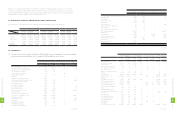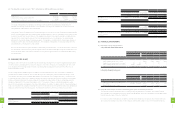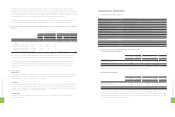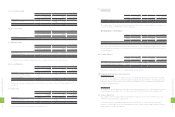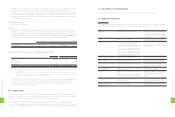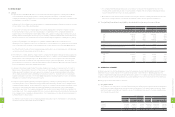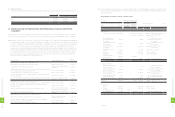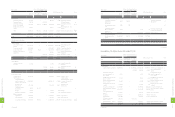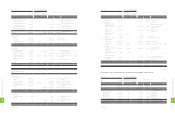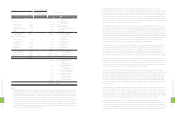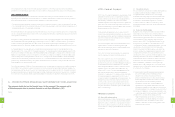HTC 2012 Annual Report Download - page 125
Download and view the complete annual report
Please find page 125 of the 2012 HTC annual report below. You can navigate through the pages in the report by either clicking on the pages listed below, or by using the keyword search tool below to find specific information within the annual report.
ROC GAAP Effect of the Transition from
ROC GAAP to IFRSs
IFRSs Amount Item Note
Item Amount
Measurement
or Recognition
Inconsistency
Presentation
Difference
NT$ NT$ NT$ NT$ US$ (Note 3)
Non-operating income and
gains
Non-operating income
and gains
Interest income $617,635 $- $- $617,635 $21,204 Interest income
Investment gain 387,478 - - 387,478 13,302 Gain on sale of
investments
Exchange gain 666,883 - - 666,883 22,894 Exchange gain
Valuation gain on financial
assets 17,417 - - 17,417 597 Valuation gain on financial
assets
Other 550,897 - - 550,897 18,913 Other
Total non-operating
income and gains 2,240,310 - - 2,240,310 76,910 Total non-operating
income and gains
Non-operating expenses and
losses
Non-operating expenses
and losses
Interest expense 1,715 - - 1,715 59 Interest expense
Loss on disposal of
Investments 165,184 - - 165,184 5,671 Loss on disposal of
Investments
Loss on disposal of
properties 6,395 - - 6,395 220 Loss on disposal of
properties
Impairment loss 1,313,353 - - 1,313,353 45,087 Impairment loss
Other 122,912 - - 122,912 4,219 Other
Total non-operating
expenses and losses 1,609,559 - - 1,609,559 55,256 Total non-operating
expenses and losses
Income before income tax 19,450,458 7,607 - 19,458,065 667,997 Income before income tax
Income tax (1,861,272) 25,000 - (1,836,272) (63,039) Income tax c)
Net income $17,589,186 $32,607 $- 17,621,793 604,958 Net income
(1,089,693) (37,409)
Exchange differences
on translating foreign
operations
6,777 232
Unrealized valuation
gain on available-for-sale
financial assets
194,052 6,662
Unrealized valuation loss
on financial instruments
for cash flow hedging
(5,383) (185) Actuarial loss on defined
benefit pension plan d)
915 31 Income tax relating to
components of OCI d)
(893,332) (30,669) OCI for the year (net of
tax)
$16,728,461 $574,289 Total comprehensive
income
Note::
a) Under ROC GAAP, the term "cash" used in the financial statements includes cash on hand, demand deposits, check
deposits, time deposits that are cancellable but without any loss of principal and negotiable certificates of deposit
that are readily salable without any loss of principal. However, under IFRSs, cash equivalents are short-term, highly
liquid investments that are both readily convertible to known amounts of cash and so near their maturity that they
present insignificant risk of changes in value. An investment normally qualifies as a cash equivalent only when it
has a short maturity of three months or less from the date of acquisition. Some certificates of deposit the Company
held had maturity of more than 3 months from the date of investment. Thus, as of January 1, 2012 and December
31, 2012, the reclassification adjustment resulted in decreases of NT$25,474,750 thousand (US$874,549 thousand)
and NT$2,911,924 thousand (US$99,967 thousand), respectively, in "cash and cash equivalents" and increases by the
same amounts in "other current financial assets - current."
b) Under ROC GAAP, a deferred income tax asset or liability should be classified as current or noncurrent in
accordance with the classification of the related asset or liability for financial reporting. However, a deferred income
tax asset or liability that is not related to an asset or liability for financial reporting should be classified as current or
noncurrent on the basis of the expected length of time before it is realized or settled. By contrast, under IFRSs, a
deferred income tax asset or liability is always classified as noncurrent. Thus, as of January 1, 2012 and December
31, 2012, the reclassification adjustment resulted in decreases of NT$2,246,196 thousand (US$77,112 thousand) and
NT$3,530,215 thousand (US$121,193 thousand), respectively, in "deferred income tax asset - current" and increases
by the same amounts in "deferred income tax assets - non-current."
Under ROC GAAP, deferred tax assets are recognized in full but are reduced by a valuation allowance account if
there is evidence showing that a portion of or all the deferred tax assets will not be realized. However, under IFRSs,
an entity recognizes only to the extent that it is highly probable that taxable profits will be available against which
the deferred tax assets can be used; thus, a valuation allowance account is not used. Thus, as of January 1, 2012 and
December 31, 2012, the reclassification adjustment resulted in decreases of NT$11,132,656 thousand (US$382,185
thousand) and NT$6,445,409 thousand (US$221,271 thousand), respectively, in "deferred income tax assets" and in
the valuation allowance account. Also, as of January 1, 2012 and December 31, 2012, the reclassification adjustment
resulted in increases of NT$340,261 thousand (US$11,681 thousand) and NT$647,936 thousand (US$22,244
thousand), respectively, in "deferred income tax assets" and "deferred income tax liabilities".
c) Under ROC GAAP, deferred income tax assets or liabilities from intergroup sales are recognized for the change
in tax basis using the tax rate of ROC. However, under IFRSs, the buyer's tax rates are used instead. Thus, the
IFRSs adjustment as of January 1, 2012 resulted in increases of NT$58,000 thousand (US$1,991 thousand) each
in "deferred income tax assets" and "accumulated earnings." In addition, the evaluation adjustment made on
December 31, 2012 resulted in increases of NT$83,000 thousand (US$2,849 thousand) in "deferred income tax
assets" and in "accumulated earnings" and a decrease in "income tax" by NT$25,000 thousand (US$858 thousand).
d) Under IFRS 1, the Company elected to recognize all cumulative actuarial gains and losses relating to employee
benefits at the date of transition to IFRSs. Thus, as of January 1, 2012, the IFRSs adjustment resulted in a decrease of
NT$83,687 thousand (US$2,873 thousand) in "accumulated earnings" due to decreases in "deferred pension cost"
by NT$342 thousand (US$12 thousand), "defined benefit assets" by NT$83,052 thousand (US$2,851 thousand) and
"net loss not recognized as pension cost" by NT$293 thousand (US$10 thousand).
As of December 31, 2012, the IFRSs adjustment resulted in a decrease in "accumulated earnings" by NT$86,417
thousand (US$2,967 thousand) due to decreases in "deferred pension cost" by NT$269 thousand (US$9 thousand),
"defined benefit assets" by NT$86,716 thousand (US$2,977 thousand), "net loss not recognized as pension cost"
by NT$347 thousand (US$12 thousand) and increase in "deferred income tax assets" by NT$915 thousand (US$31
thousand). In addition, this adjustment resulted in decreases in "cost of revenues" by NT$473 thousand (US$16
thousand), "selling and marketing expenses" by NT$526 thousand (US$18 thousand), "general and administrative
expenses" by NT$193 thousand (US$7 thousand) and "research and developing expenses" by NT$545 thousand
(US$19 thousand).
e) Under ROC GAAP, if an obligation is probable (i.e., likely to occur) and the amount could be reasonably estimated,
it is a contingent liability and should be accrued for, but under which account is not clearly defined. However, under
IFRSs, it defines "provisions" as obligations that are probable (i.e., more likely than not) and the amount could be
reasonably estimated. Thus, as of January 1, 2012 and December 31, 2012, the reclassification adjustment resulted in
decreases of NT$15,133,275 thousand (US$519,526 thousand) and NT$8,881,514 thousand (US$304,903 thousand),
respectively, in "other current liabilities" and increases by the same amounts in "provisions - current."
f) Accumulated compensated absences are not addressed in existing ROC GAAP; thus, the Company has not
recognized the expected cost of employee benefits in the form of accumulated compensated absences at the end
of reporting periods. However, under IFRSs, when the employees render services that increase their entitlement
to future compensated absences, an entity should recognize the expected cost of employee benefits at the end of
reporting periods. Thus, as of January 1, 2012, the IFRSs adjustment resulted in an increase in "accrued expenses"
2
4
6
8
FINANCIAL INFORMATION
2
4
7
8
FINANCIAL INFORMATION


